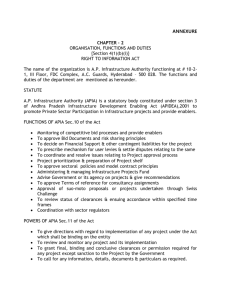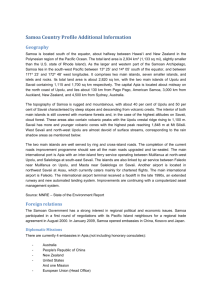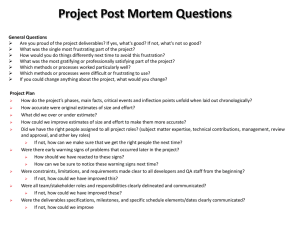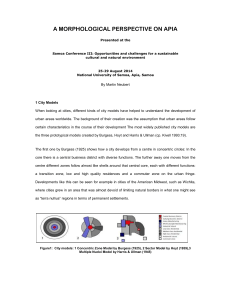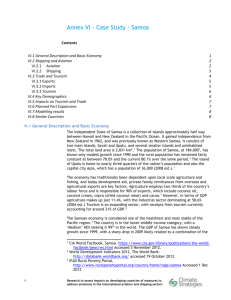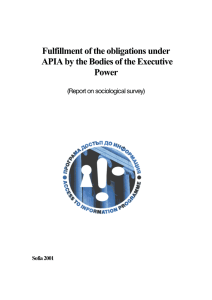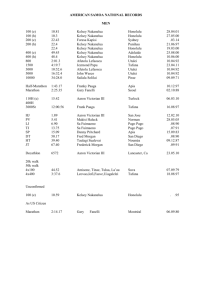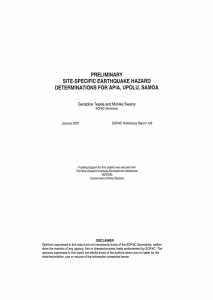Integrated Safeguards Data Sheet - Documents & Reports
advertisement
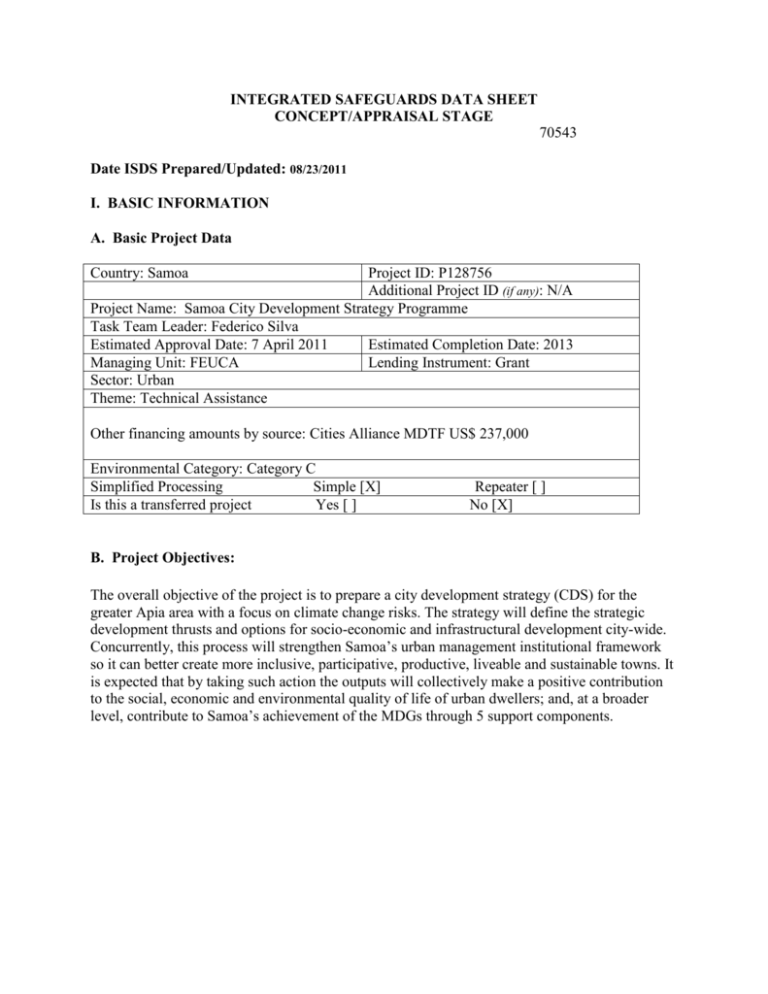
INTEGRATED SAFEGUARDS DATA SHEET CONCEPT/APPRAISAL STAGE 70543 Date ISDS Prepared/Updated: 08/23/2011 I. BASIC INFORMATION A. Basic Project Data Country: Samoa Project ID: P128756 Additional Project ID (if any): N/A Project Name: Samoa City Development Strategy Programme Task Team Leader: Federico Silva Estimated Approval Date: 7 April 2011 Estimated Completion Date: 2013 Managing Unit: FEUCA Lending Instrument: Grant Sector: Urban Theme: Technical Assistance Other financing amounts by source: Cities Alliance MDTF US$ 237,000 Environmental Category: Category C Simplified Processing Simple [X] Is this a transferred project Yes [ ] Repeater [ ] No [X] B. Project Objectives: The overall objective of the project is to prepare a city development strategy (CDS) for the greater Apia area with a focus on climate change risks. The strategy will define the strategic development thrusts and options for socio-economic and infrastructural development city-wide. Concurrently, this process will strengthen Samoa’s urban management institutional framework so it can better create more inclusive, participative, productive, liveable and sustainable towns. It is expected that by taking such action the outputs will collectively make a positive contribution to the social, economic and environmental quality of life of urban dwellers; and, at a broader level, contribute to Samoa’s achievement of the MDGs through 5 support components. C. Project Description: The project consists of the following components: Component 1. Assessment, Analysis and Strategy. The component includes community assessments, urban profiles and vulnerability studies of the focus area. It develops the Vision for the development of the targeted areas, reflecting their comparative advantages (through SWOT analysis) and longer-term development including a strategy for addressing hardship(s) and climate change. Deliverables: Urban Profiling of Apia and other identified urban centers in the focus area; Vulnerability Assessment with reference to climate change risks in greater Apia; Participatory SWOT Analysis; CDS Vision and Prioritized Strategies for greater Apia. Component 2. Supporting Infrastructure Investment Programme for Priority Projects. The component aims at identifying priorities and potential funding sources for infrastructure development to meet the long-term development objectives of greater Apia. Any follow-on infrastructure investments will undergo individual safeguard due diligence process. Deliverables: Investment Plan identifying investment priorities, approximate costing, and potential sources of funding. Component 3. Institutional Strengthening. This component aims at assessing the needs of local and national institutions including those identified in Planning and Urban Management Agency’s (PUMA) Capacity Building Plan, 2008-2011 and contributing to needs assessment for the next training cycle. The component will also develop a capacity action plan through a stakeholder participatory “learning by doing” approach. Deliverables: Reports Training of trainers (ToT) events in relevant local institutions; Capacity action plan for institutional strengthening Component 4. Policy Learning and Knowledge Sharing. This component aims at the dissemination of some of the major project deliverables (the City Profile, CDS vision, and Investment Plan) to initiate a dialogue for policy reform at the national level on CDS and its relevance to planning and development. The component also includes documentation and sharing of the implementation process and the lessons learned. Deliverables: Policy proposition papers on the relevance of CDS as a planning tool; Report on the Policy Learning Dialogue with PUMA, relevant Ministries, on the significance of the CDS experience; Documentation of the CDS implementation and experiences; Knowledge Sharing Plan to disseminate CDS main outputs (diagnosis, vision, investment program) and support transfer of good practices to other cities. Component 5. Monitoring and Evaluation (M&E). This component establishes an M&E framework for monitoring the follow up process of implementation of the CDS, and evaluating its achievements and the eventual outcomes. Deliverables: An M&E Framework developed by PUMA for long terms assessment of CDS’ impact. All project’s activities and deliverables are of analytic nature. Project activities will not involve any direct buying of equipment and/or building/construction and no World Bank parallel, associated or follow on investments are expected, which include physical work. Other follow up investment are currently non-secured. The project’s environmental and social impacts will be negligible and will not produce any irreversible environmental or social impacts that could trigger safeguards policies. On the contrary, part of the deliverables includes a vulnerability assessment which will highlight resiliency in the greater Apia with regard to climate change and social issues. D. Project location and salient physical characteristics relevant to the safeguard analysis (if known): Samoa has a national population of 195,234 persons (2006) of which 40% is urban with most of its population living in the capital Apia and the adjoining northwest slopes of Upolu Island. The Apia urban area grew to 38,836 people in 2001. Adding two administrative districts to east and west of the core Apia urban area gives a population of 60,872 or 35 per cent of the 2001 national population. If all of the north west of the main island of Upolu is taken into account, then this population, including Apia, increases to 52 per cent (2001) of the total population of Samoa (Sagapolutele et al, 2003).The rapidly increasing population in these areas is exerting pressure on all aspects of urban infrastructure, land use and development, including the provision of social services. Furthermore, with more than 80% of the country’s economic activity and population concentrated in coastal areas (including its capital Apia), it is extremely vulnerable to natural hazards and the adverse impacts of climate change on often fragile ecosystems. Urban coastal areas are prone to erosion, flooding and landslides and other natural disasters such as cyclones. The vulnerabilities of these areas are exacerbated as Samoa is experiencing higher temperatures, rising sea level, declining marine resources and losses of flora and fauna. E. Borrower’s Institutional Capacity for Safeguard Policies: This is s Recipient Executed (RE) grant. The grant recipient is the United Nations Human Settlements Programme, UN-Habitat. UN-Habitat is the United Nations agency for human settlements. It is mandated by the UN General Assembly to promote socially and environmentally sustainable towns and cities with the goal of providing adequate shelter for all. UN Habitat has been a recipient of a significant number of Cities Alliance grants and with the World Bank were its founding members. UN-Habitat is also currently a member of the Cities Alliance Executive Committee. Mr. Chris Radford, UN-Habitat, will manage project implementation. Federico Silva, Junior Professional Officer, FEUCA, from the World Bank will supervise implementation. F. Environmental and Social Safeguards Specialist: Not Applicable: The project activities are analytical in nature and will have negligible environmental and social impact. The project has been classified as OP/BP 4.01 “Category C” and therefore no Environmental and Social Management Plan is required. II. SAFEGUARD POLICIES THAT MIGHT APPLY Safeguard Policies Triggered (please explain why) Environmental Assessment (OP/BP 4.01) Yes No X Natural Habitats (OP/BP 4.04) X Forests (OP/BP 4.36) X Pest Management (OP 4.09) X Physical Cultural Resources (OP/BP 4.11) X Indigenous Peoples (OP/BP 4.10) X Involuntary Resettlement (OP/BP 4.12) X Safety of Dams (OP/BP 4.37) X Projects on International Waterways (OP/BP 7.50) X Projects in Disputed Areas (OP/BP 7.60) X Piloting the Use of Borrower Systems to Address Environmental and Social Safeguard Issues in BankSupported Projects (OP/BP 4.00) X TBD III. SAFEGUARD PREPARATION PLAN A. Target date for the Quality Enhancement Review (QER), at which time the PAD-stage ISDS would be prepared: N/A B. For simple projects that will not require a QER, the target date for preparing the PAD-stage ISDS: N/A C. Time frame for launching and completing the safeguard-related studies that may be needed. The specific studies and their timing1 should be specified in the PAD-stage ISDS: N/A IV. APPROVALS Signed and submitted by: Task Team Leader: Approved by: Cities Alliance Safeguards Focal Point or Regional Safeguards Coordinator: Comments: Program Manager: Comments: 1 Federico Silva 08/23/2011 Phyllis Kibui 11/03/2011 William Cobbett 11/04/2011 Reminder: The Bank's Disclosure Policy requires that safeguard-related documents be disclosed before appraisal (i) at the InfoShop and (ii) in-country, at publicly accessible locations and in a form and language that are accessible to potentially affected persons.
